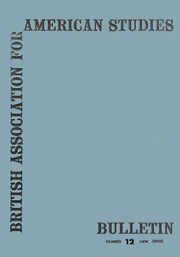No CrossRef data available.
Article contents
The Impact of the New Deal on British Economic and Political Ideas
Published online by Cambridge University Press: 17 February 2011
Extract
The most important statement of Britain's economic and social aims to emerge from the experience of the depression and the Second World War was Beveridge's “Full Employment in a Free Society”. Published in 1944 it marks a revolution in the thinking of liberal economists. Laissez-faire is almost totally discarded. What replaces it is not socialism, but the socialisation of effective demand; the responsibility is thrust upon the State for the provision of income sufficiently large for the full employment of the human resource of labour. There were in 1944 (as there still are) many unfinished arguments concerning the best means of implementing the aim of full employment, but the responsibility of Central Governments in this matter is not in doubt. As the Times stated editorially “There is no question whether we can achieve full employment: we must achieve it. It is the central factor which will determine the pattern of national life after the war, including, perhaps, the fate of democratic institutions.” The revolution in thought which this editorial view point represents had something to do with the New Deal, but how much? in what respects was the New Deal influential? Can we separate out from the whole Anglo-American depression experience some particular features of America's recovery programme and distinguish them as influential in British thinking? I think that we cannot; but there is no doubt, on the other hand, that in the long conversation between British and American economists which went on through the 1930's and into the war years, American views and American experience made themselves felt amongst British economists.
- Type
- Research Article
- Information
- Copyright
- Copyright © British Association for American Studies 1962




